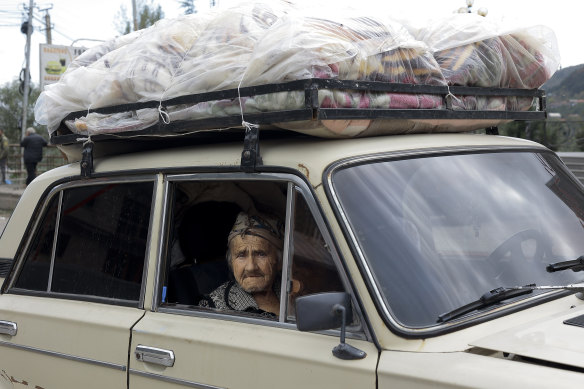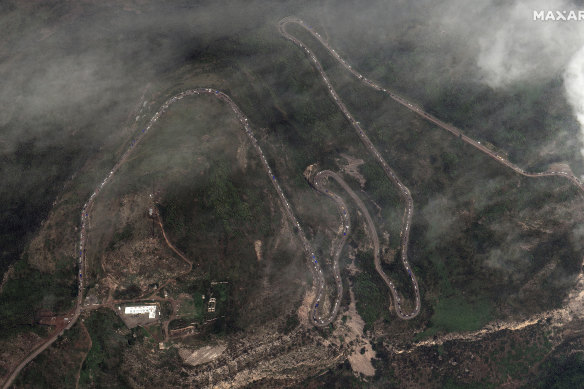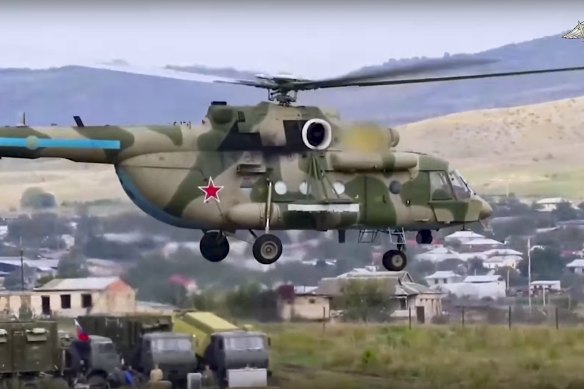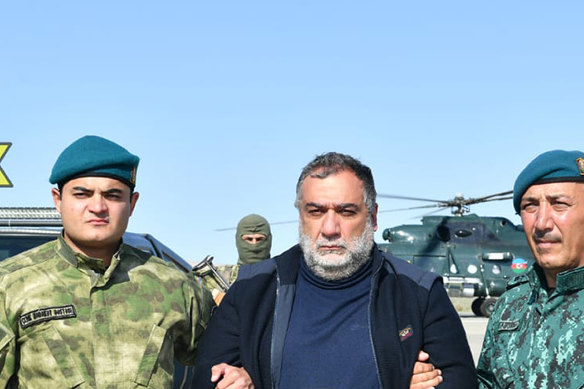
Save articles for later
Add articles to your saved list and come back to them any time.
Yerevan, Armenia: The separatist government of Nagorno-Karabakh said on Thursday it will dissolve itself and the unrecognised republic will cease to exist by year’s end after a nearly three-decade bid for independence, while Armenian officials said over half of the region’s population has already fled.
The moves came after Azerbaijan carried out a lightning offensive last week to reclaim full control over the region and demanded that Armenian troops in the region also known as Artsakh disarm and the separatist government dissolve itself. Analysts believe Azerbaijan, which is backed by Turkey, may have received a green light from Russia which previously backed Armenia.
An ethnic Armenian from Nagorno-Karabakh sits in an old Soviet style car as she flees in Armenia’s Goris in Syunik region.Credit: AP
A decree signed by the region’s separatist President Samvel Shakhramanyan cited an agreement reached on September 20 to end the fighting under which Azerbaijan will allow the “free, voluntary and unhindered movement” of Nagorno-Karabakh residents to Armenia.
That touched off the mass exodus of ethnic Armenians from the mountainous region inside Azerbaijan on Sunday. By Thursday morning, more than 66,000 people — more than half of Nagorno-Karabakh’s population of 120,000 had fled to Armenia, and the influx continued with unabating intensity, according to Armenian officials.
After separatist fighting ended in 1994 following the collapse of the Soviet Union, Nagorno-Karabakh came under the control of ethnic Armenian forces, backed by Armenia. Then, during a six-week war in 2020, Azerbaijan took back parts of the region in the south Caucasus Mountains along with surrounding territory that Armenian forces had claimed earlier.
a long traffic jam of vehicles along the Lachin corridor in the Nagorno-Karabakh region as thousands flee Azerbaijan’s takeover.Credit: Maxar Technologies
Nagorno-Karabakh was internationally recognised as part of Azerbaijan’s sovereign territory.
In December, Azerbaijan imposed a blockade of the only road connecting Nagorno-Karabakh with Armenia, alleging the Armenian government was using the road for mineral extraction and illicit weapons shipments to the region’s separatist forces.
Armenia alleged the closure denied basic food and fuel supplies to Nagorno-Karabakh. Azerbaijan rejected the accusation, arguing the region could receive supplies through the Azerbaijani city of Aghdam – a solution long resisted by Nagorno-Karabakh authorities, who called it a strategy for Azerbaijan to gain control of the region.
Weakened by the blockade, with Armenia’s leadership distancing itself from the conflict, ethnic Armenian forces in the region agreed to lay down arms less than 24 hours after Azerbaijan began its offensive last week. Talks have begun between Baku and Nagorno-Karabakh’s separatist authorities on “reintegrating” the region back into Azerbaijan.
A Russian peacekeepers’s military helicopter transports a wounded person from a field hospital in Nagorno-Karabakh to the Armenian side on Tuesday.Credit: Russian Defence/AP
Azerbaijani authorities have pledged to respect the rights of ethnic Armenians in the region and restore supplies.
Many residents, however, have decided to leave for Armenia, fearing reprisals. The only road linking Nagorno-Karabakh to Armenia quickly filled with cars, creating a massive traffic jam on the winding mountain road.
There have been no reports so far of residents burning down their houses before leaving — something that happened in 2020 when people fled territories taken over by Azerbaijan.
On Monday night, a fuel reservoir exploded at a petrol station where people lined up for fuel that was in short supply from the blockade. At least 68 people were killed and nearly 300 injured, with over 100 others still considered missing.
It isn’t immediately clear if the ethnic Armenians still living in the region will remain there. Shakhramanyan’s decree urged Nagorno-Karabakh’s population – including those who left – “to familiarise themselves with the conditions of reintegration offered by the Republic of Azerbaijan, in order to then make an individual decision about the possibility of staying in (or returning to) Nagorno-Karabakh”.
Azerbaijan’s border guard officers hold Ruben Vardanyan, centre. The former head of Nagorno-Karabakh’s separatist government was detained after he tried to cross into Armenia on Wednesday.Credit: AP
On Thursday, Azerbaijani authorities charged Ruben Vardanyan, the former head of Nagorno-Karabakh’s separatist government, with financing terrorism, creating illegal armed formations and illegally crossing a state border. Vardanyan, a billionaire banker who was arrested on Wednesday, faces up to 14 years in prison if convicted, according to Russia’s state news agency RIA Novosti.
Azerbaijani officials said Vardanyan, who made his fortune in Russia, was detained as he was trying to enter Armenia from Nagorno-Karabakh along with thousands of others and taken to Baku. The arrest appeared to indicate Azerbaijan’s intent to quickly enforce its grip on the region.
Vardanyan moved to Nagorno-Karabakh in 2022 and headed the regional government for several months before stepping down earlier this year.
Another top separatist figure, Nagorno-Karabakh’s former foreign minister and now presidential adviser David Babayan, said on Thursday he would surrender to Azerbaijani authorities after they “demanded my arrival in Baku for a proper investigation.” Babayan said in a Facebook post that he will head from Stepanakert, the region’s capital, to the nearby city of Shusha, which has been under Azerbaijani control since 2020.
“My failure to appear, or worse, my escape, will cause serious harm to our long-suffering people, to many people, and I, as an honest person, hard worker, patriot and a Christian, cannot allow this,” Babayan said.
AP
Most Viewed in World
From our partners
Source: Read Full Article



